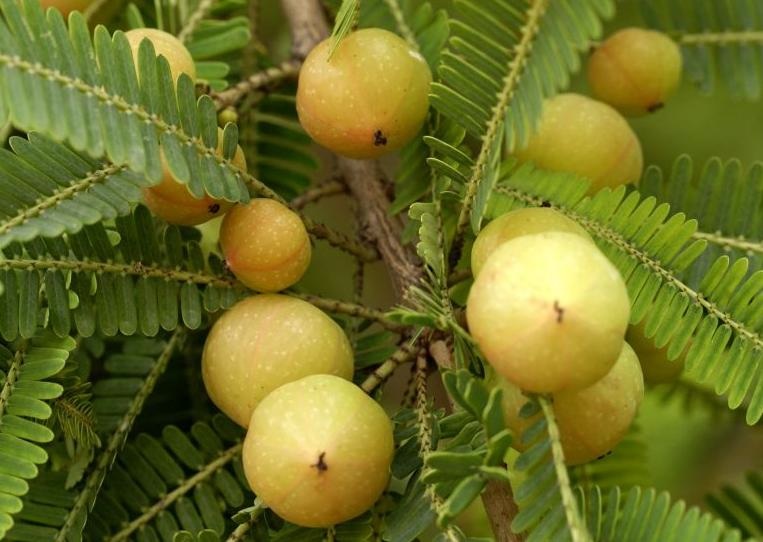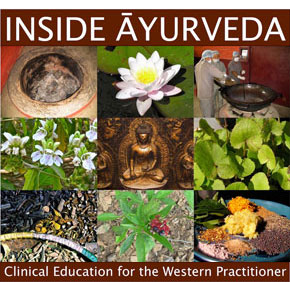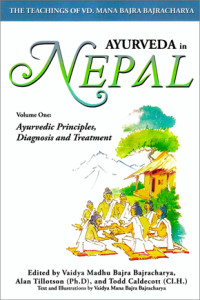Among the thousands of different herbs and formulas used in Ayurveda, there is perhaps none better known and celebrated than the medicated herbal jam called Chyavanprash. It is named after Chyavana muni, a forest-dwelling sage that had long turned his back on the world, who was enticed into marriage by the great beauty of the princess Sukanya. Being withered and aged, Chyavana enlisted the help of the Ashwin Kumaras, the celestial physicians, to create a formula that would restore his youth, and the result of these efforts was Chyavanprash.
Chyavanprash is classified as a rasayana, a medication that helps to promote youthfulness and prevent disease, helping one to ‘follow’ (‘ayana’) into the ‘juiciness’ of life (‘rasa’). It was already acclaimed as famous in the Charaka samhita, an ancient text of Ayurveda that is well over 2000 years old. Apart from helping to restore youthfulness and prevent aging, the Charaka samhita mentions the utility of this formula in the treatment of chronic respiratory disorders including bronchitis and asthma. It benefits wasting diseases and immunodeficiency syndromes, and is particularly helpful in weakness and fatigue. Indicated for all people including both the aged and children, Chyavanprash is traditionally stated to enhance the intellect, mind and senses, and helps to boost fertility, digestion and the luster of the skin.
Chyavanprash is called a ‘lehya’, which means to ‘to lick’, and each dose is traditionally licked off a spoon followed by warm water or boiled milk. Although variations exist, the Charaka samhita states that Chyavanprash contains 41 different herbs prepared in a base of honey, ghee, sesame oil and sugar.* The primary ingredient is the sour-tasting Amalaki fruit (Phyllanthus emblica), a remarkable herb with potent antioxidant properties which is a rasayana in its own right. Amalaki is notable for its high vitamin C content, as well as other medicinally active constituents including diterpenes, triterpenes, flavonoids, polyphenols, alkaloids, and benzenoids such as ellagic acid. Medical research on Amalaki has demonstrated adaptogenic, antiinflammatory, antimicrobial, antitumor, anti-atherosclerotic and immune-enhancing effects. Other beneficial herbs in Chyavanprash include Agnimantha, Bilwa, Pippali, Gokshura, Haritaki, Guduchi, Musta, Vasaka, Ela and Nagakeshara.
While Chyavanprash is powerful restorative, in order to see the real benefits it should be taken for a sustained period of at least 1-2 years. The typical dose is 1-2 tbsp twice daily, or more, depending on the strength of digestion. There are many different types of Chyavanprash in the marketplace and a huge range in quality. It can be found easily enough at your local Indian grocery store, although after observing the effects and tasting many different types of Chyavanprash, as well as talking to Ayurvedic physicians in both India and Nepal, I have become increasingly skeptical of their benefit. When I was in Nepal in 2009 I had the benefit of witnessing the traditional preparation of Chyavanprash at a facility owned and operated by Vaidya Madhu Bajra Bajracharya. Vaidya Madhu is the inheritor of an 800 year old hereditary tradition of Ayurveda, and the methods of making Chyavanprash has been carefully passed down from generation to generation. Vaidya Madhu’s pharmacy manufactures a whole range of Ayurvedic products including lehyas (herbal jams), gutikas (hand-rolled pills) and bhasmas (purified metals).
*The complete list of ingredients for Chyavanprash includes Amalaki fruit (Indian gooseberry / amla / Phyllanthus emblica), Bilwa fruit (bael / Aegle marmelos), Agnimantha (Premna integrifolia), Syonaka (Indian trumpet flower / Oroxylon indicum), Kashmari (kashmari / Gmelina arborea), Patala (Stereospermum personatum), Bala plant (country mallow / Sida cordifolia), Prisniparni plant (Uraria lagopoides), Shalaparni plant (Desmodium gangeticum), Masaparni (Teramnus labialis) , Mudgaparni (Phaseolus trilobus), Pippali fruit (long pepper / Piper longum), Gokshura fruit (Tribulus terrestris), Brihati shrub (vrihati / Solanum indicum), Kantakari herb (Black nightshade / Solanum xanthocarpum), Karkatashringi fruit gall (Insect gall on Pistacia intergerrima), Tamalaki herb (Phyllanthus niruni), Draksha fruit (grape / Vitis vinifera), Jivanti leaf (lettuce / Lactuca sativa), Nilotpalam flower (blue lotus / Iris nepalensis), Agaru wood (eaglewood / Aquilaria agallocha), Haritaki fruit (Terminalia chebula), Guduchi stem (Tinospora cordifolia), Vriddhi tuber (Paris polyphylla, big), Jivaka bulb (wild garlic / Allium wallichii, small), Karchura (zedoary /Curcuma zedoaria), Musta tuber (Cyperus rotundus), Punarnava plant/root (Boerhavia difusa), Ela fruit (greater cardamon / Amomum subulatum), Rakta Chandanam wood (red sandalwood / Pterocarpus santalinus), Utpala (Nymphaea stellata), Vidari tuber (Ipomea paniculata), Vasaka leaf (Malabar nut / Adhatoda vasica), Kakoli bulb (Fritillaria cirrhosa), Kakanasika shrub (Leea aquata), Tila seed oil (sesame / Sesamum indicum), ghrita (ghee / clarified butter), Vetasa (cane sugar, brown / Saccharum officinarum), madhu (honey), Vamsalochana (Bamboo manna / Bambusa breviflora), Pippalamulam (long pepper root / Piper longum), Twak bark (Cinnamon / Cinnamomum zeylanicum), Suksmaila seed (cardamom / Elettaria cardamomum), Patram leaf (Cassia cinnamon / Cinnamomum tamala) and Nagakesara seed/flower (ironwood tree / Mesua ferrea).






